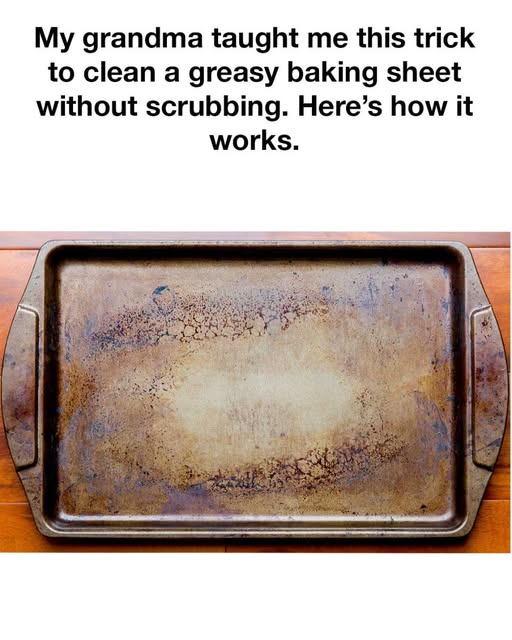The Baking Sheet Cleaning Hack Everyone Should Know: Baking Soda and Vinegar Magic
If you’ve ever opened your oven to find a baking sheet coated in stubborn, baked-on grease, you’re not alone. Many home cooks face the same problem—crusted food bits, burnt oil stains, and a surface that looks beyond saving. But before you toss that pan in frustration or spend hours scrubbing, let us share an incredible cleaning hack passed down through generations.
This simple kitchen trick—using just baking soda and vinegar—can save you serious time, effort, and money. Best of all? It’s non-toxic, eco-friendly, and safe for your hands and your cookware.
Why Traditional Cleaning Methods Fall Short
Scrubbing with steel wool, soaking overnight, or using harsh chemical cleaners might help remove grime, but they come with downsides:
- Time-consuming and labor-intensive
- Risk of scratching nonstick or aluminum surfaces
- Exposure to strong, synthetic chemicals
- Damage to your pan’s finish over time
Instead, the answer may be hiding right in your pantry.
The Natural Duo: Baking Soda and Vinegar
These two everyday kitchen staples are more than just cooking ingredients—they’re powerful natural cleaners.
Baking Soda: The Gentle Scrubber
- Mildly abrasive yet non-damaging
- Neutralizes odors
- Absorbs grease and oil
- Lifts burnt-on food without harsh friction
Vinegar: The Acidic Degreaser
- Breaks down oils, grease, and protein-based residues
- Natural disinfectant
- Reacts with baking soda to fizz and lift grime
- Non-toxic and biodegradable
Step-by-Step: How to Clean a Greasy Baking Sheet Effortlessly
Here’s how to use baking soda and vinegar to restore your baking sheet to its original shine in just a few simple steps.
Step 1: Sprinkle Baking Soda Generously
Lay your dirty baking sheet flat in your sink or on a waterproof surface. Take a generous amount of baking soda and sprinkle it liberally over all the greasy, burnt-on areas. Don’t skimp—cover every visible stain.
Pro Tip: Pay special attention to the corners and edges where grime tends to build up.
Step 2: Add Vinegar to Activate
Slowly pour white vinegar over the baking soda. You’ll instantly see a fizzy, bubbling reaction—this is where the magic happens. The chemical reaction between baking soda (a base) and vinegar (an acid) helps lift and loosen grease and carbonized food.
Let the reaction bubble up and work for a few seconds before moving on.
Step 3: Let It Sit and Soak
Now it’s time to be patient. Allow the mixture to sit undisturbed for 15 to 30 minutes. This soaking period gives the solution time to:
- Penetrate stubborn grease layers
- Loosen hardened food residue
- Deodorize your baking sheet
The longer it sits, the better it works. For extra-tough stains, leave it on for up to an hour.
Step 4: Scrub Lightly
After the wait, take a soft sponge, nylon scrubber, or even an old toothbrush and gently scrub the surface. You’ll notice that the grime lifts easily—no excessive pressure or steel wool needed.
Focus on any remaining tough spots with circular motions. If needed, sprinkle a little more baking soda for added abrasion.
Step 5: Rinse and Reveal
Rinse the sheet thoroughly with warm water. You’ll be amazed at how effortlessly the burnt-on mess washes away, revealing a clean, shining surface underneath.
Dry it with a clean towel or let it air-dry. Your baking sheet will look refreshed and ready for your next culinary adventure.
Why This Hack Works So Well
This technique isn’t just a fluke—it’s backed by science and has stood the test of time. Here’s why it’s so effective:
- The abrasive nature of baking soda physically lifts grime without damaging your pan.
- Vinegar’s acidity dissolves carbon buildup and greasy films.
- The chemical reaction between the two creates carbon dioxide gas, which agitates and dislodges tough debris.
- It’s 100% safe, non-toxic, and inexpensive.
Which Types of Baking Sheets Does This Work On?
This method is ideal for:
- Aluminum baking sheets
- Stainless steel pans
- Enamel-coated bakeware
- Roasting pans and trays
Avoid using vinegar on cast iron or nonstick surfaces if they’re not dishwasher safe—prolonged exposure to acid can damage coatings.
Optional Add-Ons for Extra Cleaning Power
Want to boost the effect? Try these additional ingredients:
- Lemon juice: Add to vinegar for extra acidity and a fresh scent
- Hydrogen peroxide: Combine with baking soda for heavy-duty cleaning
- Dish soap: Add a few drops for a grease-cutting boost
Prevent Future Buildup on Your Baking Sheets
Keep your pans cleaner for longer by following these simple tips:
- Line pans with parchment paper or silicone baking mats
- Clean immediately after use—don’t let grease sit overnight
- Use a baking rack to elevate food and reduce direct contact
- Avoid using cooking sprays that leave a sticky residue over time
Eco-Friendly and Budget-Friendly
This method isn’t just effective—it’s also good for the environment and your wallet:
- No need for disposable cleaning wipes
- Avoids synthetic cleaners with toxic ingredients
- Utilizes ingredients you already have at home
- Saves water by eliminating the need for long soaking and multiple scrubs
Final Thoughts
The next time your baking sheet comes out looking like a battlefield, remember this simple, time-tested hack. With baking soda and vinegar, you don’t need to scrub for hours or spend a fortune on specialty cleaners. It’s fast, effective, and safe for you and the planet.
Try it once, and you’ll never go back.
